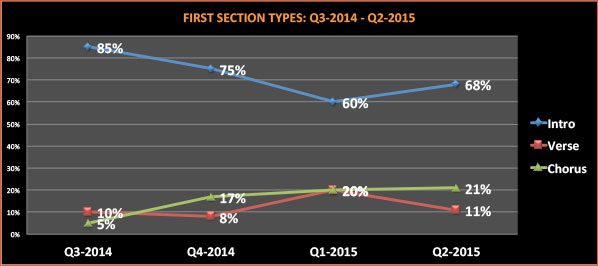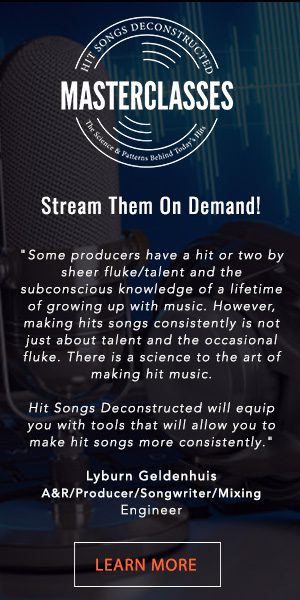During the second quarter of 2015 (April – June), 19 songs had the distinction of charting in the Top 10 of the Hot 100. They were a diverse group, spanning 5 primary genres and 18 distinct sub-genre and influencer categories.
Among them are remix/alternate versions of songs that hit big (Cheerleader – Felix Jaehn Remix and Bad Blood featuring Kendick Lamar), songs possessing non-typical elements that enabled them to stand out from the pack (the “Rosie” Blues influenced Hey Mama and the Country, Hoedown influenced Honey, I’m Good), and 70s/80s Retro influenced hits such as Shut Up And Dance and Want To Want Me, to name just a few.
Despite their differences, the key commonality that all these songs share is their meticulously well-crafted nature. All are primed for maximum impact with their core target demographic, and contain a wealth of hooks, clever elements, and WOW factors to get the job done.
Our Q2-2015 Top 10 Deconstructed Report explores the what, how, and why behind today’s hits, revealing what makes them so infectious, engaging, and memorable. What follows is a sampling of standout factors and characteristics that are explored in depth throughout the report.
Most of the songs that chart in the top 10 are chock-full of infectious hooks, clever elements and WOW factors that help to put them over-the-top and stand out from their mainstream contemporaries. Prime examples from Q2’s hits include:
Artist dig: Bad Blood was allegedly written about the “bad blood” between Taylor Swift and Katy Perry. Interestingly, the song features key elements that are found in some of Katy Perry’s hits, such as the “militaristic” background “hey” vocals in Dark Horse, and the lead vocal “hey” shouts, which are featured in Roar. Additionally, the common denominator that all these songs share is Max Martin as a co-writer.
Non-typical instrumentation: It’s very rare for a Top 10 hit to feature a prominent trumpet in the mix, especially in the role of a key hook. This is one of the primary factors that enable Cheerleader (Felix Jaehn Remix) to really stand out among its mainstream contemporaries.
Non-typical influence: The featuring of the “Rosie” Blues/call and response sample throughout the song acts as a key infectious element. It also provides the song with a unique identity, which helps it to stand out among its mainstream contemporaries.
Vocal hook: The “oh-oh-oh-oh-oh” synth/vocal hook acts as a unique infectious element in the intro, chorus and bridge sections.
Recognizable influences: The song features a very strong Whitney Houston I Wanna Dance With Somebody influence, as well as the “shots, shots, shots, shots” inspired vocal from LMFAO’s “Lil John Shots.”
The manner in which a song begins is of the utmost importance. If the listener’s attention isn’t instantly captured, what comes next won’t matter, because they’re not going to stick around to find out.
Three different methods were utilized to kick off a song in Q2 – a verse, a chorus, or an intro.
The least popular method was to immediately kick off with the verse. Accounting for just 11% of songs, it’s represented by FourFiveSeconds and Thinking Out Loud. However, this method is effective because it instantly thrusts the listener into the “meat” of the song, fully engaging them from the get go.
The second most popular method was to immediately kick off with the chorus. This was indicative of 21% of songs, which include Bad Blood and Honey I’m Good. However, the number jumps to 41% when you take into account songs that have their first chorus following the intro and preceding the first verse. Among the representatives are G.D.F.R. and See You Again.
The most popular method was to utilize an intro, which was indicative of 68% of songs. Among the different types of intros used to begin a song, three of the most effective are the “Multifaceted intro,” the “Hook intro” and the “Artist Plug intro.”
The Multifaceted intro is especially useful in songs that possess a relatively long intro. New elements enter the mix throughout, which keeps the listener engaged until the next section takes over.
A good example from Q2 is Taylor Swift’s Style, which lands at 19-seconds. The first half of the intro features funky guitar and a couple of synths in the mix. Together, they establish a funky, moody (slightly dark), retro 80s vibe. Note that there’s a low to high EQ sweep in effect as well. The second half of the section adds driving bass and 80s natured drums into the mix, all of which serve as the backing music for the verse that directly follows.
The Hook intro is an exceptionally effective way to instantly “hook” the listener into a song. This is because they’re being introduced to what is one of, if not THE most infectious element in the song right from the get-go.
The hook can be vocal, instrumental, or a combination of the two. Two examples from Q2 are the “doh, doh, doh” vocal hook in Uptown Funk, and the “Rosie” sample that kicks off Hey Mama.
An “artist plug” intro serves as “free marketing” built directly into a song. This is especially important in an airplay environment when an artist is not announced before or after the song is played. By having the artist plugged directly in the song, it enables the listener to easily track it down and become a fan. It also heightens the visibility and clout of the artist each and every time the song is played. A few examples from Q2 are:
Somebody: 0:04 – This intro accomplishes a lot in just four-seconds. It establishes two of the song’s key hooks – the processed “oh-oh-oh-oh-oh” vocal and the retro synth bass hook, and features an artist plug as well– Natalie La Rose. The two aforementioned hooks then carry right over into the Whitney Houston-inspired chorus that follows, which seals the deal.
Time Of Our Lives: Even though the song technically doesn’t contain an intro (it kicks off with the chorus), it wouldn’t be a Pitbull song if “Mr. Worldwide” and the featured artist (Ne-Yo) weren’t announced at some point. This happens at 21 and 28-seconds into the song, respectively.
Trap Queen: 0:15 – The song features a kid announcing “RGF productions” at the onset, followed by a processed vocal stating “Remy Boyz, yaaahhhhh.” Wap then enters the mix at the tail end with “1738, ah,” before heading into the first verse. Note that this intro is also technically a “backing music” intro as well, considering that the synths from the intro remain in effect in the first verse.
These are just a few of the many characteristics and techniques hit songwriters employed to propel their songs up the charts during the second quarter of 2015.
To view the full Q2-2015 Hit Songs Deconstructed Top 10 Deconstructed Report, click here.




